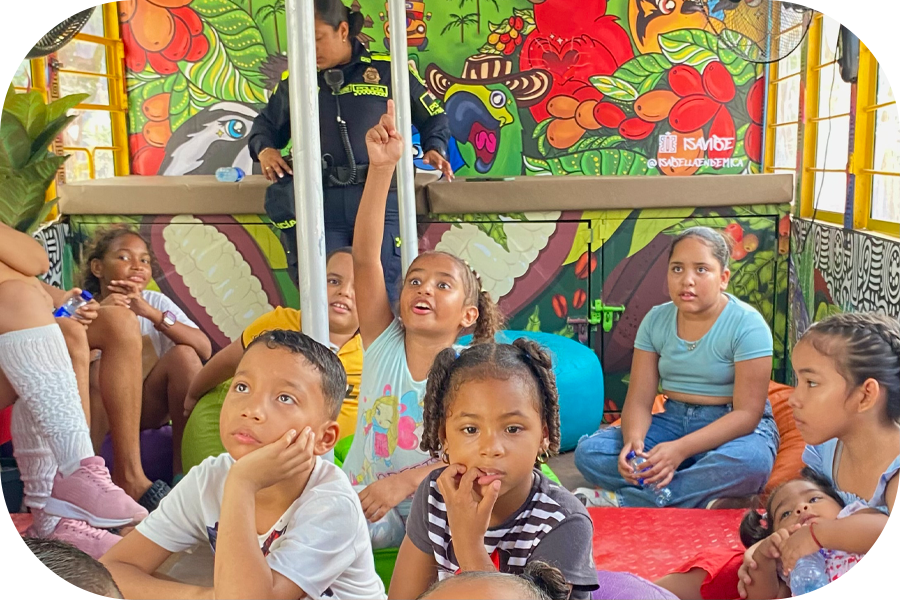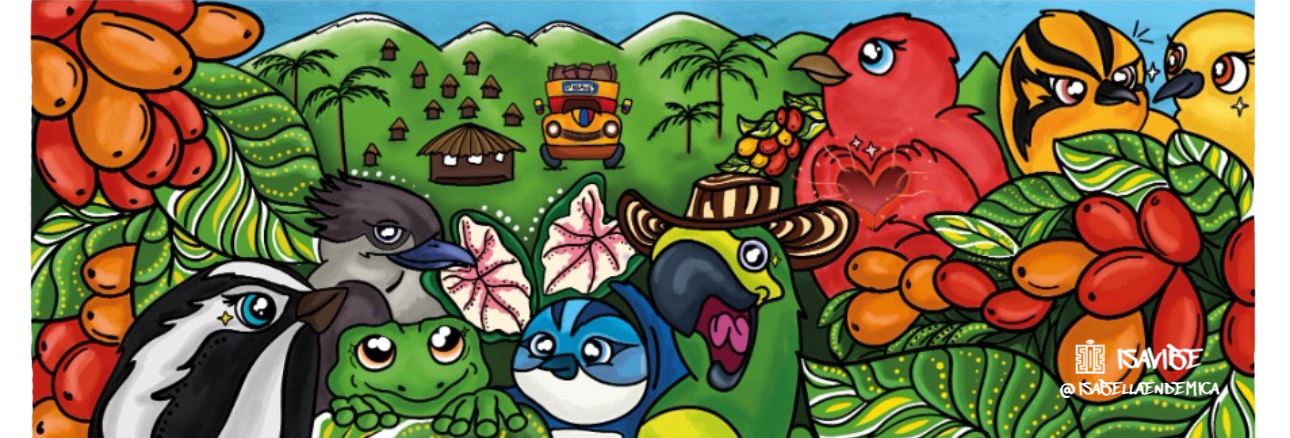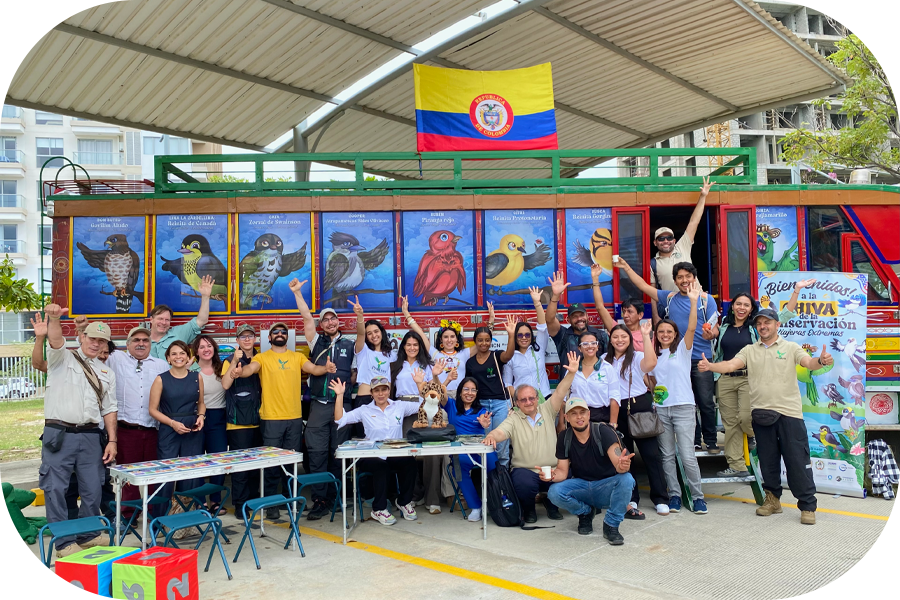Earlier this month, on International Women’s Day, we recognised the power of women-led conservation, intergenerational wisdom, and the resilience of grassroots organisations working tirelessly to protect our planet. Today, we continue to celebrate and highlight their vital contributions.
At the heart of this movement is a story deeply rooted in family, passion, and purpose – one that spans three generations of women dedicated to safeguarding nature and empowering communities.
Founded by myself, Sara Inés Lara, Women for Conservation has grown from a grassroots initiative into a global movement dedicated to empowering women in conservation. As a Member of the International Union for Conservation of Nature (IUCN), Women for Conservation actively participates in key environmental forums, including the IUCN World Conservation Congress and the Convention on Biological Diversity (CBD) meetings.
A mother’s influence, A daughter’s vision

For my daughter, Isabella Cortes Lara, and me, conservation is more than a profession – it is a way of life, passed down from mother to daughter like an ancestral tradition. It is an ethos woven into our daily work, where science meets artistry, and where leadership is guided by the nurturing hands of women.
Having worked in conservation for over 25 years, I have witnessed first-hand the challenges that women face in this field. Running an organisation from a woman's perspective is often more complex, with limited funding, systemic barriers, and the additional emotional labour that comes with community-based work. But it is also deeply rewarding – because when women lead, conservation efforts become more inclusive, sustainable, and rooted in long-term impact.
Isabella has taken this legacy and expanded it into new dimensions, incorporating art, music, and storytelling into conservation efforts. Through Women for Conservation, she has built a global network of women-led environmental organisations, bringing together over 25 institutions to amplify their voices and share resources. By partnering with the Prince Bernhard Nature Fund and their Conservation Connect Circles, she has established an international network where grassroots women leaders can access funding, mentorship, and visibility.
Building a global circle: Women for Conservation and the IUCN Red List

In November 2024, we launched the Women for Conservation Circle as part of the Conservation Connect initiative. This circle focuses on organisations tackling climate change, biodiversity loss, and species conservation – many of which work in some of the world’s most vulnerable regions. Conservation Connect (CC) is an online platform that connects grant makers with nature conservationists, fosters networks, and enhances the visibility of organisations. It equips grant makers with tools to work more efficiently, accelerate processes, and maximise the impact of their grants. Additionally, it supports local conservation projects by increasing their visibility, credibility, networks, and access to funding.
Women for Conservation establishes project sites in areas where biodiversity is most vulnerable, prioritising regions identified through the IUCN Red List of Threatened Species’. By aligning our efforts with this globally recognised database, we ensure that our conservation initiatives focus on the most at-risk species and habitats. Our project sites serve as focal points for community-driven conservation, where local women are empowered as guardians of their ecosystems. Through habitat restoration, sustainable livelihood programmes, and educational outreach, we integrate scientific data with grassroots action to protect critically endangered species.
 Our approach is simple: we identify strong grassroots partners and provide them with opportunities to apply for funding, mentorship, and global recognition. Through an invitation-only process, selected organisations receive small grants that can have a profound impact on their work. For example, Roseline from Fridays for Future in Sierra Leone recently secured a 10,000-euro grant, enabling her to expand conservation efforts in her community.
Our approach is simple: we identify strong grassroots partners and provide them with opportunities to apply for funding, mentorship, and global recognition. Through an invitation-only process, selected organisations receive small grants that can have a profound impact on their work. For example, Roseline from Fridays for Future in Sierra Leone recently secured a 10,000-euro grant, enabling her to expand conservation efforts in her community.
Beyond funding, our monthly meetings provide a space where women leaders from West Africa, Madagascar, Nepal, Latin America, and beyond can share challenges, exchange solutions, and find strength in solidarity. We are not just funding projects – we are building a movement. By fostering collaboration between organisations and aligning our priorities with the IUCN Red List, we maximise the effectiveness of conservation efforts worldwide, ensuring that both people and the planet thrive together.
Why Women? Why Now?
Women play a critical role in conservation, particularly in Indigenous and rural communities, where they are often the primary stewards of natural resources. Yet, they remain underrepresented in leadership roles and overlooked in funding opportunities. This is why our work is so urgent. When women lead, conservation succeeds – not only because they bring unique perspectives and knowledge, but because they anchor environmental efforts in the wellbeing of families and future generations.
Pregnancy, motherhood, and intergenerational wisdom are central to this work. Just as my mother inspired me, and I inspired Isabella, we see this cycle repeated in the communities we support. Women pass down traditional ecological knowledge to their daughters, ensuring that conservation is not just a short-term intervention, but a lifelong commitment.
Art as a Tool for Conservation

We are setting our sights forward to the IUCN World Conservation Congress 2025, where we hope to present a dynamic art exhibit showcasing the transformational power of creativity and education in biodiversity conservation. This interactive exhibit will focus on the rediscovery of the critically endangered Lynch’s Colombian Tree Frog (Hyloscirtus lynchi), the primary species for which the Rana Chiva was designed. Listed on the IUCN Red List, this species disappeared for over 36 years and has become a symbol of conservation efforts in Colombia.
The exhibit will also highlight the success of the Rana Chiva mobile classroom, a project that has brought conservation education to over 35,000 rural children in some of Colombia's most remote communities – making conservation education accessible, engaging, and inspiring.
I sabella Cortés Lara, known artistically as ISAVIBE, served as the creative director of Fundacion ProAves’ innovative environmental education initiative, the Rana Chiva mobile classroom. This project utilises a traditional Colombian bus, or "chiva," which Isabella transformed with her artwork into a vibrant mobile tropical environment designed to engage communities in conservation efforts.
sabella Cortés Lara, known artistically as ISAVIBE, served as the creative director of Fundacion ProAves’ innovative environmental education initiative, the Rana Chiva mobile classroom. This project utilises a traditional Colombian bus, or "chiva," which Isabella transformed with her artwork into a vibrant mobile tropical environment designed to engage communities in conservation efforts.
Under Isabella's leadership, the Rana Chiva offers interactive activities, games, and workshops aimed at fostering a love for nature and promoting biodiversity protection among children and adults. The initiative educates people about species conservation in a way that is both informative and immersive – a real life “Magic School Bus” for the environment.
 Beyond her work with the Rana Chiva, Isabella has also composed the conservation anthem "Agüita de Páramo”. This song and music video bring to life the trills of the Lynch's Colombian Tree Frog, intertwining environmental messages with ancestral sounds to raise awareness and foster deep emotional connections to nature. Isabella's fusion of art, music, and environmental education exemplifies how creativity can make conservation efforts more accessible, relatable, and memorable, inspiring communities to actively participate in protecting their natural heritage.
Beyond her work with the Rana Chiva, Isabella has also composed the conservation anthem "Agüita de Páramo”. This song and music video bring to life the trills of the Lynch's Colombian Tree Frog, intertwining environmental messages with ancestral sounds to raise awareness and foster deep emotional connections to nature. Isabella's fusion of art, music, and environmental education exemplifies how creativity can make conservation efforts more accessible, relatable, and memorable, inspiring communities to actively participate in protecting their natural heritage.
For a visual insight into the Rana Chiva initiative, you can watch the following documentary: Conservation Impact in Colombia.
A Call to Action: Changing the Culture of Conservation
 Conservation is about protecting life for the benefit of society and the world as a whole. Yet, like many other sectors, the field of conservation is not immune to systemic challenges. Competition for funding, lack of visibility, and unequal resource distribution are still very much present.
Conservation is about protecting life for the benefit of society and the world as a whole. Yet, like many other sectors, the field of conservation is not immune to systemic challenges. Competition for funding, lack of visibility, and unequal resource distribution are still very much present.
Large organisations with substantial marketing budgets and dedicated communication teams dominate the funding landscape, while smaller, grassroots initiatives – often led by women in the field – struggle to be seen. This is not because they lack impact, but because they lack the tools to make their work visible. This systemic imbalance keeps the biggest players growing while those on the ground, making direct changes, struggle to sustain themselves.
 But it doesn’t have to be this way. Conservation should not be a competition. If one organisation receives funding, it does not diminish opportunities for another. Success is not a limited resource – blessings are meant to be shared. We must shift the culture of conservation from scarcity to abundance, from isolation to interconnectedness.
But it doesn’t have to be this way. Conservation should not be a competition. If one organisation receives funding, it does not diminish opportunities for another. Success is not a limited resource – blessings are meant to be shared. We must shift the culture of conservation from scarcity to abundance, from isolation to interconnectedness.
As climate change intensifies and global crises escalate, competition for resources will only grow fiercer. This is why we must rethink how we operate as a conservation community. How can we uplift smaller organisations? How can we ensure that those working directly with nature – especially women – have access to the support they need? The future of conservation depends on collaboration, not rivalry.
Let’s plant the seed of change today – a new way of thinking, where success is measured not by how much one organisation can achieve alone, but by how strong we can grow together.
Here’s to the mothers, daughters, and granddaughters who continue to lead the way.
Yours in Conservation!
— Sara & Isabella

Photo Credits - Women For Conservation